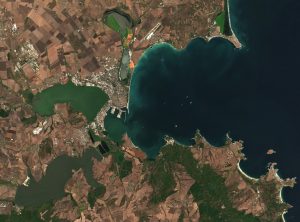Last week, customs authorities in the Bulgarian port of Burgas found nearly 1,000 pounds of heroin stashed inside a trailer that had arrived in late July from the Georgian port of Batumi. The cargo reportedly arrived in Batumi overland from Kyrgyzstan before making the journey across the Black Sea.
This is probably not the increase in trade officials are hoping for when talking up new transport routes to connect Central Asia to Europe. But trade in illicit goods tends to follow the same pathways as licit trade, and there is money to be made.
The heroin seized in Bulgaria is estimated to be worth nearly $38 million.
Law enforcement officials in Bulgaria said in an August 12 press release that they have initiated an investigation into the smuggling of 436 kilograms (961 pounds) of heroin found inside 434 plastic bags hidden within a shipment’s officially declared cargo: four cable-laying machines. Anti-drug unit chief Ivan Sokolov told reporters that the shipment’s unusually long stay in the port raised suspicions and x-rays prompted a physical inspection during which the drugs were discovered in “factory cavities in the machines, which were welded and without direct access.”
The Bulgarian authorities said in their press release that the cargo was being transported from Kyrgyzstan to Greece, via Bulgaria. It did not specify the exact route from Kyrgyzstan to Georgia – likely through Kazakhstan and across the Caspian Sea to Azerbaijan. And the press release did not offer any further details about the ownership of the cargo or theories as to who put heroin inside the cable-laying machines and at which point in the journey (though the fact that the drugs were welded into the machines suggests they weren’t stashed mid-trip).
“So far, there have been no arrests, and no persons found involved in this cross-border crime,” district prosecutor Georgi Chinev told the Associated Press.
According to RFE/RL’s Kyrgyz Service, Kyrgyzstan’s Ministry of Internal Affairs rejected the claim that the seized heroin originated in Kyrgyzstan. The ministry also noted that it was in contact with the Bulgarian authorities.
In a 2014 book and a 2017 article for CSIS’ Reconnecting Asia, Dr. Louise Shelley argued that “the present-day drug trade follows very similar routes to that of the historic silk road.”
“Today, the expansion of connections across Asia may bring some development opportunities to Central Asia, but perils remain because the new silk road is a conduit for many illicit forms of trade,” she concluded seven years ago.
That statement has only grown more astute as trade and transportation networks proliferate across Central Asia, the latest wave spurned on by the geopolitical pressures rerouting trade away from Russia. Routes such as the Trans-Caspian International Transport Route (TITR), also referred to as the Middle Corridor, have been described as a gateway to Europe for Central Asia. Trade from the region following the Middle Corridor funnels into Kazakhstan and across the Caspian Sea to Azerbaijan, where it travels overland to Georgia’s Black Sea ports and from there the world. The Middle Corridor’s pros and cons have been widely discussed, from security concerns regarding the Black Sea and the war in Ukraine, to the financial logic of a land route competing with sea routes.
Another challenge will be confronting and mitigating the illicit drug trade that is sure to shadow the increase in legitimate trade regional government’s publicly hope for.
According to the United Nations Office on Drugs and Crime (UNODC), Afghanistan “supplies 80 percent of global opiate demand.” Some amount of those opiates – which include heroin – traverse Central Asia, and with new routes springing up, the pathways proliferate.
Significant investments in combating the drug trade across Central Asia over the last two decades have yielded few tangible results when it comes to stymying global drug supplies, but have served to deepen authoritarianism in the region. Reported drug busts barely scratch the surface.

































